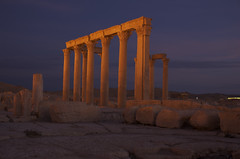The Serpentine Gallery is a small art space in Kensington Gardens that is run with an expert mind and the vision for making a splash. The exhibitions change frequently, are to the point and cost nothing to see. But it is the annual architectural commission that makes this place special. Every year, a practice is invited to design and install a pavilion next to the gallery that will provide space for visitors to relax, have a tea and contemplate the connections between art and architecture.
The commission has been run since 2000. At the beginning, only architects that hadn't worked in Britain before could be selected. This stipulation seems to have been relaxed this year, when Ai Weiwei and Herzog & de Meuron were asked to perform. Ai Weiwei has indeed not built anything in Britain, but he's an artist rather than an architect, despite his involvement with the Olympic Stadium in Beijing. Herzog & de Meuron, of course, created Tate Modern and are currently overseeing its expansion. Could it be that appointing this partnership served to send a reminder to the Chinese government of Ai Weiwei's standing in the art world?
Political considerations apart, I had reasons to be apprehensive about this year's pavilion. It was an excavated structure, an artificial cave, not exactly the first thing you'd associate with park and summer. As I approached the pavilion, I only saw its roof, a flat circular disk just about a meter off the ground that rain had turned into a reflection pool. The space below was dark. Rough shapes were all I could make out. I descended a few steps and exited the park. It felt a bit like stepping into a neglected pedestrian tunnel underneath a large railway station, solitary bulbs on the ceiling given a dim, rather localized light. Dullness and drabness engulfed me.
All around was nothing but concrete, the coarse mix of cement and rough pebbles that I remember from my childhood when city centers built or spiffed up in the 60s and 70s were clad and decorated with it. There is nothing pretty about the material. It looks like something unsuccessfully designed to look like granite, a cheap substitute, decoration intended to appear noble and elegant but with the opposite effect. Dreadful.
It was raining. Underneath the disk, a few dozen visitors were huddled in a grim underworld, mere silhouettes against the dark background. Quick first glances confirmed my suspicions about the design, but as I looked more closely, my perception changed. People appeared joyfully out of synch with the dreariness of their immediate surroundings, chatting, picnicking, having coffee from the stall just outside, or reading the newspaper the Serpentine hands out for free thanks to its media sponsor. Kids were bouncing about, screeching with bliss. On concrete, I wondered?
I had read that archaeology was a theme of the pavilion. Remnants of the previous eleven structures were apparently incorporated into the design. Foot-high walls crisscrossed the ground like foundations. The pillars and wall segments, twelve in total, that held the roof also referenced past pavilions. There was no repetition and no symmetry. Little stools stood here and there, solid, massive and wider at the top than at the bottom. Made from concrete, they were accidents waiting to happen, tipping over and crushing visitors' toes.
The previous big Ai Weiwei presence in town, the hundred million porcelain sunflower seeds on the floor of Tate Modern's Turbine Hall, had to be fenced off despite the intentions of the artist because the walking and playing of the gallery visitors on them during the first two days had produced enough dust to give everyone potter's rot. Where was Health & Safety? The pavilion had been open for more than a month.
I sat down on a stool, and suddenly it all made sense. The stool was made from cork, as was the entire pavilion. Cork covered all surfaces, and the mock foundation walls were cork as well. The cork looked like bargain-basement concrete, but was slightly springy and a pleasure to sit on. And while it continued to rain outside, the cozy cove was dry and warm.
With the help of the weather, Ai Weiwei and Herzog & de Meuron have created an absolute masterpiece, spot on. In the heat of a real summer, it would be unbearably oppressive, but during the current wash-out, record-rainy already and predicted to get worse, the Serpentine Pavilion might just be the best place to be outside in London.

No comments:
Post a Comment